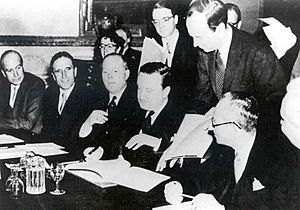London Agreement on German External Debts facts for kids
The London Debt Agreement was a special deal made in 1953. It helped West Germany pay back money it owed to many countries after World War II. This agreement was signed in London on February 27, 1953. It officially started on September 16, 1953.
Contents
Why the Agreement Was Needed
After World War II, Germany owed a lot of money to many countries. These debts came from before the war and from help given after the war. In 1951, the United States and the United Kingdom told other countries that they wanted to help Germany settle these debts. They said they would even reduce what Germany owed them if a good plan was made.
Germany's leader, Konrad Adenauer, agreed that Germany wanted to pay its debts. So, a big meeting called the London Debt Conference happened in 1952. Countries worked together to find a fair way for Germany to pay back what it owed. The agreement they reached was signed in 1953.
Countries Involved in the Agreement
Many countries were part of this agreement. Besides West Germany, these included:
- Belgium
- Canada
- Ceylon (now Sri Lanka)
- Denmark
- France
- Greece
- Iran
- Ireland
- Italy
- Liechtenstein
- Luxembourg
- Norway
- Pakistan
- Spain
- Sweden
- Switzerland
- South Africa
- United Kingdom
- United States of America
- Yugoslavia
Countries from the Eastern Bloc (like the Soviet Union) were not part of this deal.
What Debts Were Covered
Germany owed money from different times. Some debts were from loans given before World War II, like those from the Dawes Plan. Other debts came from economic help given to Germany after the war. This help included programs like GARIOA and the Marshall Plan.
The agreement focused on specific types of debts:
- Money owed that was fixed and due before May 8, 1945.
- Money owed from loans or credit contracts made before May 8, 1945.
- Money owed from other contracts due before May 8, 1945.
Claims from countries damaged by Germany during World War II were not part of this agreement. Those would be handled differently later.
How Debts Were Reduced
The London Agreement was based on three main ideas to help Germany:
- The total amount Germany had to pay was greatly reduced.
- Germany was given a very long time to pay back the money. This helped its economy grow.
- The amount Germany paid each year depended on how well its economy was doing. This meant Germany would only pay what it could afford.
Before the agreement, Germany owed about 16 billion marks from World War I debts. It also owed another 16 billion marks from loans after World War II. The agreement cut these debts by about half, to around 15 billion marks. Germany was given 30 years to pay this back.
A very important part of the deal was that Germany only had to make payments if its exports were doing well. Payments were limited to 3% of what Germany earned from exports. This encouraged other countries to buy German goods, which helped Germany rebuild.
For the first five years (until 1958), Germany only had to pay the interest on its debts. This gave its economy more time to get stronger before starting to pay the main amounts.
After 1958, Germany paid a fixed amount of 765 million marks each year. As Germany's exports grew, these payments became much easier to handle. Most of the debts were paid off by the 1970s. The last payment on these specific debts was made in 1983.
Debts After German Reunification
A small part of the agreement said that some debts would be paid after Germany became one country again. For a long time, this seemed unlikely. But when Germany reunified in 1990, about 239.4 million Deutsche Mark in deferred interest became due.
Germany made the final payment on these bonds on October 3, 2010. This was the very last payment Germany made on known debts from both world wars.
How Negotiations Happened
The negotiations started with the Allies creating a special group. This group's job was to figure out which debts the London Agreement would cover. Both sides, Germany and the Allies, talked as equals during these discussions.
Important meetings took place in Bonn and London in 1951 and 1952. The 1952 meeting was key. They discussed the total debt amounts and how long Germany would have to pay. Germany's good negotiating skills played a big part in the final outcome.
Impact of the Agreement
The London Agreement was a huge success for Germany. It helped the country's economy grow very quickly after the war. Germany became a strong economic power again.
Here's how the agreement helped:
- It gave Germany more money to spend on public projects, like roads and schools.
- It made it cheaper for Germany to borrow money.
- It helped keep prices stable and stopped inflation.
The agreement also allowed Germany to join important international groups like the World Bank and the International Monetary Fund. Studies have shown that it led to more spending on health, education, housing, and economic development in West Germany.
Before 1953, West Germany's new money, the Deutsche Mark, was not very stable. After the agreement, it became much stronger. West Germany quickly changed from a country that owed money to a country that others owed money to. Many people call this period Germany's "economic miracle."
See also
- German reparations for World War II
- Marshall Plan
- World War I reparations
- Dawes Plan
- Young Plan
- Hoover Moratorium
 In Spanish: Acuerdo de Londres de 1953 sobre la deuda alemana para niños
In Spanish: Acuerdo de Londres de 1953 sobre la deuda alemana para niños


